|
To many of us, John Wayne has entertained
us for decades, on both the big screen and on our television
sets. Throughout most of his career, John Wayne played the part
of the man who stood for what was right against the evil in this
world. Even when he played the part of the man who was in the
wrong, such as in Red
River, he was still an on-screen hero.
Sure, Wayne was just an actor. He wasn’t even
John Wayne. He was born Marion Michael Morrison in
Winterset, Iowa May 26, 1907. However, John Wayne represented
America and the Old West, maybe not exactly the way that it
really was, but the way that we would like for it to have been.
He has effected the hearts and minds of the people of this
country more than most Presidents have or ever will. He has
inspired patriotism when it was sorely lacking in our country.
Before we go into the life of John Wayne too deeply, let’s
look at the gun that Ruger has created as a tribute to
the one hundredth anniversary of his birth.
I have reviewed the Ruger New Vaquero
twice before; once when it
first went into production, and again
about a year later. This New Vaquero featured here
differs very little from those earlier New Vaqueros, except in
the detail of its fit and finish. I have found every New Vaquero
that I have fired to shoot very well. In the New Vaquero, Ruger
corrected some of the long-standing criticisms of the New Model
Blackhawk and Vaquero designs. The chamber throats on .45
caliber New Vaqueros are of the proper size, with those on this
John Wayne gun measuring a perfect .4515 inch diameter. That is
just the right size for shooting cast .452 diameter bullets, and
also works well for .451 jacketed bullets.
On this John Wayne sixgun, Ruger wisely chose to
give the gun a nice polished blue finish, instead of the
case-colored frame of the standard New Vaquero. The grips are
checkered walnut, and have the initials "JW" inscribed
into them on each grip panel near the bottom. The frame, barrel,
grip frame, and cylinder are engraved in a light scroll pattern
that is nicely done, and tasteful. The engraving looks
much better than most of the engraving that I have seen on other
Ruger revolvers recently. It is of course machine engraved, but
it looks darn good. John Wayne’s signature is inscribed
in gold atop the barrel. This John Wayne revolver seems to be
fitted better than the average New Vaquero also. I have examined
five of these personally, and all are as well done as is mine.
These John Wayne sixguns have a special serial number range,
which is highly unusual for Ruger to do. The serials start at
JW001 and run through JW03500. Mine is JW00071. Like all New
Vaquero revolvers, the chambers line up correctly with the
loading gate for loading and unloading. It also has the new key
lock, which is hidden beneath the grips. One must drill a hole
in the right grip panel to use the key lock feature. Mine will
never be drilled, as the feature is not needed, but is
unobtrusive and there if the owner desires. The barrel/cylinder
gap on my sample measures a nice even .003 inch. The trigger
pull measured about four and one-quarter pounds as delivered,
but a quick Poor Boy’s Trigger Job
improved that dramatically. These guns come from the
factory with a plastic wire tie around the hammer to preserve
the perfection of the cylinder finish, if the owner chooses to
not fire the sixgun.
Shooting the John Wayne Vaquero proved to be a
real pleasure. Firing offhand at 25 yards, the sights were dead
on for me. I really like that. All three of my New Vaquero
revolvers are sighted correctly for my chosen loads, and that
makes things real handy. I now have .45 Colt New Vaqueros in all
three barrel lengths; four and five-eighths (this John Wayne
gun), five and one-half, and seven and one-half inches.
Shooting the John Wayne Ruger from the Ransom
rest at 25 yards, the gun performed very well, grouping
five shots within one and one-half inches, and ten shots right
at two inches, with two different handloads. I fired no jacketed
bullets through this Ruger. It will have a life of shooting my
favorite .45 Colt bullet; the Mt.
Baldy 270 SAA, pushed to about 800 feet-per-second. That
bullet weighs in at about 285 grains lubed.
The John Wayne Ruger comes packaged in a
specially-marked red plastic hard case, with a special outer
sleeve and booklet.
I am very glad to see that Ruger is offering
this tribute to John Wayne. The man was a true American, on and
off the screen. I did not know him, except through his movies.
However, I am honored to own and shoot this gun which is a
tribute to John Wayne, who himself was a tribute to the way that
America should be.
Check out the full line of Ruger products
here.
For the location of a Ruger dealer near you,
click on the DEALER FINDER icon at www.lipseys.com.
Jeff Quinn
|
To locate a dealer where you can
buy this gun, Click on the DEALER FINDER icon at: |
|

|
  
John Wayne 1907-2007

For a brief biography on John Wayne, I am
not qualified to do such, but instead I will refer you to this
biography written by his close friend, and our former president,
Ronald Reagan. It was written shortly after Mr. Wayne’s
death in 1979, and was published in the Reader’s Digest:
Unforgettable John Wayne
biography by Ronald Reagan
courtesy of Readers Digest - October 1979
We called him DUKE, and he was every bit the
giant off screen he was on. Everything about him - his stature,
his style, his convictions-conveyed enduring strength, and no
one who observed his struggle in those final days could doubt
that strength was real. Yet there was more. To my wife, Nancy,
"Duke Wayne was the most gentle, tender person I ever
knew."
In 1960, as president of the Screen Actors'
Guild, I was deeply embroiled in a bitter labor dispute
between the Guild and the motion picture industry. When we
called a strike, the film industry unleashed a series of
stinging personal attacks on me - criticism my wife found
difficult to take.
At 7:30 one morning the phone rang and Nancy
heard Duke's booming voice: "I've been readin' what these
damn columnists are saying about Ron. He can take care of
himself, but I've been worrying about how all this is affecting
you." Virtually every morning until the strike was settled
several weeks later, he phoned her. When a mass meeting was
called to discuss settlement terms, he left a dinner party so
that he could escort Nancy and sit at her side. It was, she
said, like being next to a force bigger than life.
Countless others were also touched by his
strength. Although it would take the critics 40 years to
recognize what John Wayne was, the movie going public knew all
along. In this country and around the world, Duke was the most
popular box-office star of all time. For an incredible 25 years
he was rated at or around the top in box-office appeal. His
films grossed $700 million - a record no performer in Hollywood
has come close to matching. Yet John Wayne was more than an
actor; he was a force around which films were made. As Elizabeth
Taylor Warner stated last May when testifying in favor
of the special gold medal Congress struck for him: "He gave
the whole world the image of what an American should be."
Stagecoach to Stardom
He was born Marion Michael Morrison in
Winterset, Iowa. When Marion was six, the family moved to
California. There he picked up the nickname Duke - after his
Airedale. He rose at 4 a.m. to deliver newspapers, and after
school and football practice he made deliveries for local
stores. He was an A student, president of the Latin Society,
head of his senior class and an all-state guard on a
championship football team.
Duke had hoped to attend the U.S. Naval Academy
and was named as an alternate selection to Annapolis, but the
first choice took the appointment. Instead, he accepted a full
scholarship to play football at the University of Southern
California. There coach Howard Jones, who often found
summer jobs in the movie industry for his players, got Duke work
in the summer of 1926 as an assistant prop man on the set of a
movie directed by John
Ford.
One day, Ford, a notorious taskmaster with a
rough-and-ready sense of humor, spotted the tall USC guard on
his set and asked Duke to bend over and demonstrate his ball
stance. With a deft kick, knocked Duke's arms from his body and
the young athlete on his face.
Picking himself up, Duke said in that voice
which then commanded attention, "Let's try that once
again." This time Duke sent Ford flying. Ford erupted in
laughter, and the two began a personal and professional
friendship which would last a lifetime.
From his job in props, Duke worked his way into
roles on the screen. During the Depression he played in grade-B
westerns until John Ford finally convinced United Artists to
give him the role of the Ringo Kid in his classic film Stagecoach.
John Wayne was on the road to stardom. He quickly established
his versatility in a variety of major roles: a young seaman in Eugene
O'Neill's The
Long Voyage Home, a tragic captain in Reap
the Wild Wind, a rodeo rider in the comedy - A
Lady Takes a Chance.
When war broke out, John Wayne tried to enlist
but was rejected because of an old football injury to his
shoulder, his age (34), and his status as a married father of
four. He flew to Washington to plead that he be allowed to join
the Navy but was turned down. So he poured himself into the war
effort by making inspirational war films - among them The
Fighting Seabees, Back
to Bataan and They
Were Expendable. To those back home and others around
the world he became a symbol of the determined American fighting
man.
Duke could not be kept from the front lines. In
1944 he spent three months touring forward positions in the
Pacific theater. Appropriately, it was a wartime film, Sands
of Iwo Jima which turned him into a superstar. Years
after the war, when Emperor Hirohito of Japan visited the
United States, he sought out John Wayne, paying tribute to the
one who represented our nation's success in combat. As one of
the true innovators of the film industry, Duke tossed aside the
model of the white-suited cowboy/good guy, creating instead a
tougher, deeper-dimensioned western hero. He discovered Monument
Valley, the film setting in the Arizona - Utah desert where a
host of movie classics were filmed. He perfected the
choreographic techniques and stuntman tricks which brought
realism to screen fighting. At the same time he decried
pornography, and blood, and gore in films. "That's not sex
and violence," he would say. "It's filth and bad
taste."
"I Sure As Hell Did!"
In the 1940s, Duke was one of the few stars with
the courage to expose the determined bid by a band of communists
to take control of the film industry. Through a series of
violent strikes and systematic blacklisting, these people were
at times dangerously close to reaching their goal. With
theatrical employee's union leader Brewer, playwright Morrie
and others, he formed the Motion Picture Alliance for the
Preservation of American Ideals to challenge this insidious
campaign. Subsequent Congressional investigations in I947
clearly proved both the communist plot and the importance of
what Duke and his friends did.
In that period, during my first term as
president of the Actors' Guild, I was confronted with an attempt
by many of these same leftists to assume leadership of the
union. At a mass meeting I watched rather helplessly as they
filibustered, waiting for our majority to leave so they could
gain control. Somewhere in the crowd I heard a call for
adjournment, and I seized on this as a means to end the
attempted takeover. But the other side demanded I identify the
one who moved for adjournment.
I looked over the audience, realizing that there
were few willing to be publicly identified as opponents of the
far left. Then I saw Duke and said, "Why I believe John
Wayne made the motion." I heard his strong voice reply,
"I sure as hell did!" The meeting and the radicals'
campaign was over.
Later, when such personalities as actor Larry
Parks came forward to admit their Communist Party
backgrounds, there were those who wanted to see them punished.
Not Duke. "It takes courage to admit you're wrong," he
said, and he publicly battled attempts to ostracize those who
had come clean.
Duke also had the last word over those who
warned that his battle against communism in Hollywood would ruin
his career. Many times he would proudly boast, "I was 32nd
in the box-office polls when I accepted the presidency of the
Alliance. When I left office eight years later, somehow the
folks who buy tickets had made me number one."
Duke went to Vietnam in the early days of the
war. He scorned VIP treatment, insisting that he visit the
troops in the field. Once he even had his helicopter land in the
midst of a battle. When he returned, he vowed to make a film
about the heroism of Special Forces soldiers.
The public jammed theaters to see the resulting
film, The
Green Berets. The critics, however, delivered some of
the harshest reviews ever given a motion picture. The New Yorker
bitterly condemned the man who made the film. The New York
Times called it "unspeakable ... rotten ...
stupid." Yet John Wayne was undaunted. "That little
clique back there in the East has taken great personal
satisfaction reviewing my politics instead of my pictures,"
he often said. "But one day those doctrinaire liberals will
wake up to find the pendulum has swung the other way.
Foul-Weather Friend
I never once saw Duke display hatred toward
those who scorned him. Oh, he could use some pretty salty
language, but he would not tolerate pettiness and hate. He was
human all right: he drank enough whiskey to float a PT boat,
though he never drank on the job. His work habits were legendary
in Hollywood - he was virtually always the first to arrive on
the set and the last to leave.
His torturous schedule plus the great personal
pleasure he derived from hunting and deep-sea fishing or
drinking and card-playing with his friends may have cost him a
couple of marriages; but you had only to see his seven children
and 21 grandchildren to realize that Duke found time to be a
good father. He often said, "I have tried to live my life
so that my family would love me and my friends respect me. The
others can do whatever the hell they please."
To him, a handshake was a binding contract. When
he was in the hospital for the last time and sold his yacht, The
Wild Goose, for an amount far below its market value, he learned
the engines needed minor repairs. He ordered those engines
overhauled at a cost to him of $40,000 because he had told the
new owner the boat was in good shape.
Duke's generosity and loyalty stood out in a
city rarely known for either. When a friend needed work, that
person went on his payroll. When a friend needed help, Duke's
wallet was open. He also was loyal to his fans. One writer tells
of the night he and Duke were in Dallas for the premiere of Chisum.
Returning late to his hotel, Duke found a message from a woman
who said her little girl lay critically ill in a local hospital.
The woman wrote, "It would mean so much to her if you could
pay her just a brief visit." At 3 o'clock in the morning he
took off for the hospital where he visited the astonished child
and every other patient on the hospital floor who happened to be
awake.
I saw his loyalty in action many times. I
remember that when Duke and Jimmy
Stewart were on their way to my second inauguration as
governor of California they encountered a crowd of demonstrators
under the banner of the Vietcong flag. Jimmy had just lost a son
in Vietnam. Duke excused himself for a moment and walked into
the crowd. In a moment there was no Vietcong flag.
Final Curtain
Like any good John Wayne film, Duke's career had
a gratifying ending. In the 1970s a new era of critics began to
recognize the unique quality of his acting. The turning point
had been the film True
Grit. When the Academy gave him an Oscar for best actor
of 1969, many said it was based on the accomplishments of his
entire career. Others said it was Hollywood's way of admitting
that it had been wrong to deny him Academy Awards for a host of
previous films. There is truth, I think, to both these views.
Yet who can forget the climax of the film? The grizzled old
marshal confronts the four outlaws and calls out: "I mean
to kill you or see you hanged at Judge Parker's convenience.
Which will it be?" "Bold talk for a one-eyed fat
man," their leader sneers. Then Duke cries, "Fill your
hand, you son of a bitch!" and, reins in his teeth, charges
at them firing with both guns. Four villains did not live to
menace another day.
"Foolishness?" wrote Chicago
Sun-Times columnist Mike Royko, describing the thrill
this scene gave him. "Maybe. But I hope we never become so
programmed that nobody has the damn-the-risk spirit."
Fifteen years ago when Duke lost a lung in his
first bout with cancer, studio press agents tried to conceal the
nature of his illness. When Duke discovered this, he went before
the public and showed us that a man can fight this dread
disease. He went on to raise millions of dollars for private
cancer research. Typically, he snorted: "We've got too much
at stake to give government a monopoly in the fight against
cancer."
Earlier this year, when doctors told Duke there
was no hope, he urged them to use his body for experimental
medical research, to further the search for a cure. He refused
painkillers so he could be alert as he spent his last days with
his children. When John Wayne died on June 11, a Tokyo newspaper
ran the headline, "Mr. America Passes On."
"There's right and there's wrong,"
Duke said in The
Alamo. "You gotta do one or the other. You do the
one and you're living. You do the other and you may be walking
around but in reality you're dead."
Duke Wayne symbolized just this, the force of
the American will to do what is right in the world. He could
have left no greater legacy.
Ronald Reagan
Visit
the Ronald Reagan Foundation online
  
Got something to say about this article? Want to agree (or
disagree) with it? Click the following link to go to the GUNBlast Feedback Page.
|
|
Click pictures for a larger version.
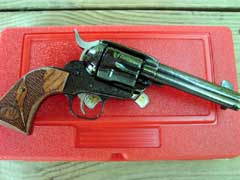
Ruger John Wayne 100th Birthday Commemorative New Vaquero .45
Colt Sixgun.


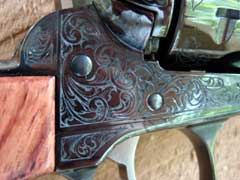
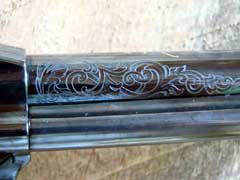
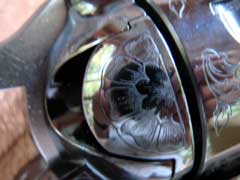
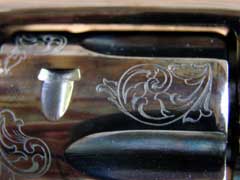
The John Wayne vaquero is finished in high-polish blue,
and tastefully engraved.
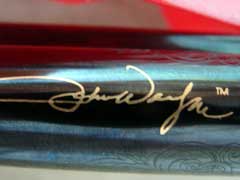
Duke's signature is gold-inlaid on the top of the
barrel.
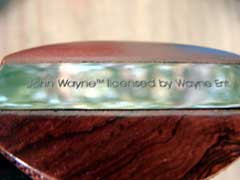
Bottom of the grip frame attests that the John Wayne
Vaquero is officially licensed by Wayne Enterprises.
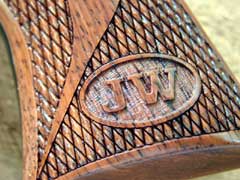

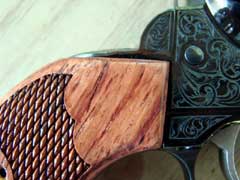
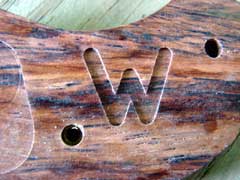
Grips are beautifully checkered, and feature
"JW" monograms and a "W" mark underneath.
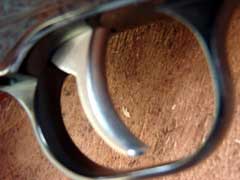
The trigger is smooth.
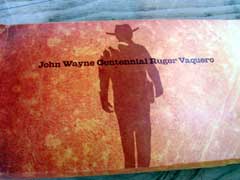

Special printed materials include an outer box sleeve
(top) and booklet about the gun (bottom).
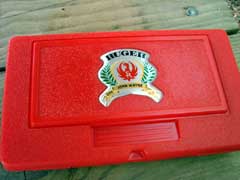
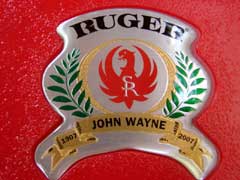
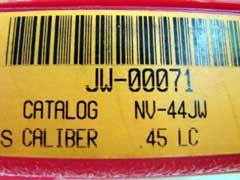
Ruger's commemorative red plastic box is specially
decorated for the John Wayne Vaquero.
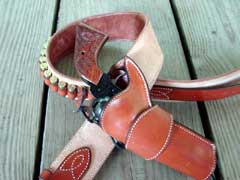
The John Wayne Vaquero is right at home in this
"Duke" style rig from Sixgunner Leather.
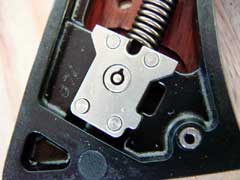
Key lock resides under the grip panel.
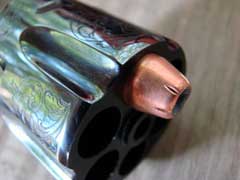
Chamber throats measure a perfect .4515 inch.
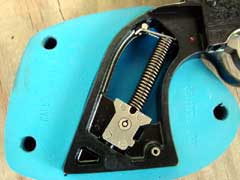
Grip frame fits perfectly in a Ransom insert made for
the Colt SAA.
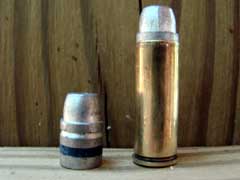
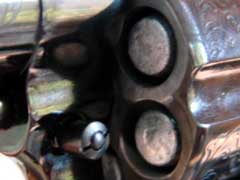
As befits this sixgun's status, only the finest cast
bullets will do: Mt. Baldy's 270 SAA.
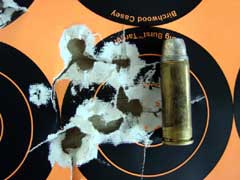
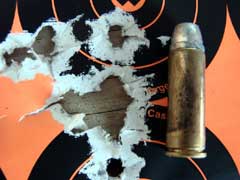
As a shooter, the John Wayne Vaquero does not
disappoint, as these sub-2" 25-yard 10-shot groups show.

Five-shot 25-yard groups measured 1.5"
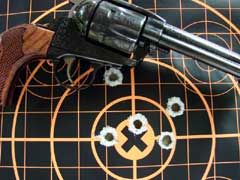
Offhand at 25 yards, the John Wayne Vaquero shoots to
point of aim.
|
![]()